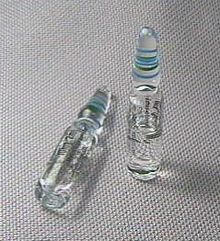| Revision as of 05:29, 4 December 2009 edit128.239.181.44 (talk)No edit summary← Previous edit | Revision as of 18:45, 15 February 2010 edit undoIce Pencil Made of Glass (talk | contribs)33 edits risks of cutting youself and getting bit of glass stuck in your handNext edit → | ||
| Line 29: | Line 29: | ||
| ] | ] | ||
| Ampoules often have colored rings of ] or ] around their necks.<!--Further details needed--> | Ampoules often have colored rings of ] or ] around their necks.<!--Further details needed--> | ||
| ==Dangers== | |||
| There is often a risk of cutting yourself on a glass ampoule. Some scientists use a special device to open the ampoules. They are seen to be the leading cause of sharps injuries in hospitals worldwide.<ref>http://be.cqu.edu.au/FCWViewer/view.do?page=6621</ref> | |||
| ==References== | ==References== | ||
Revision as of 18:45, 15 February 2010


An ampoule (also ampule or ampulla) is a small sealed vial which is used to contain and preserve a sample, usually a solid or liquid. Ampoules are commonly made of glass, although plastic ampoules do exist.
Modern ampoules are most commonly used to contain pharmaceuticals and chemicals that must be protected from air and contaminants. They are hermetically sealed by melting the thin top with an open flame, and usually opened by snapping off the neck. If properly done, this last operation creates a clean break without any extra glass shards or slivers; but the liquid or solution may be filtered for greater assurance. The space above the chemical may be filled with an inert gas before sealing. The walls of glass ampoules are usually sufficiently strong to be brought into a glovebox without any difficulty.
Glass ampoules are more expensive than bottles and other simple containers, but there are many situations where their superior imperviousness to gases and liquids and all-glass interior surface are worth the extra cost. Examples of chemicals sold in ampoules are injectable pharmaceuticals, air-sensitive reagents like tetrakis(triphenylphosphine)palladium(0), hygroscopic materials like deuterated solvents and trifluoromethanesulfonic acid, and analytical standards.
Historic ampoules
Historically ampoules were used to contain a small sample of a person's blood after death, which was entombed alongside them in many Christian catacombs. It was originally believed that only martyrs were given this burial treatment, but many believe that it was a widely-practiced tradition.
San Gennaro
An ampoule, allegedly dating back to the year 305 and filled with the blood of Saint Januarius (San Gennaro), bishop of Benevento, has been kept for centuries in the Cathedral at Naples. Every year on the 19th of September the town celebrates the Feast of San Gennaro, when the solid reddish-brown contents of the ampoule usually liquifies after being taken out of a safe, carried in procession and placed on the Cathedral's altar.
Sainte Ampoule

Another well known ampoule is the Holy Ampulla (Sainte Ampoule) which held the anointing oil for the coronation of the French monarchs. The oil was allegedly passed down from the time of Clovis I; it was kept for a time in the tomb of Saint Remigius and later in the Cathedral of Notre-Dame, Reims. An order of knights named after the ampoule was created for the coronation of kings. The ampoule was smashed in 1793 by French revolutionaries; however, a portion of the oil was supposed to have been saved and was used in coronation of Charles X.
Other
During their marriage, Angelina Jolie and Billy Bob Thornton wore ampoules of each others' blood around their necks.
Production
Modern glass ampoules are produced industrially from short lengths of glass tubing, shaped by heating with gas torches and gravity in automated production lines. Computer vision techniques are usually employed for quality control.
The filling and sealing of ampoules may be done by automated machinery on an industrial scale, or by hand in small-scale industries and laboratory settings. Blank ampoules may be purchased from scientific glass supply houses and sealed with a small gas torch. A Schlenk line may be used for sealing under inert atmospheres.
Ampoule codes

Ampoules often have colored rings of paint or enamel around their necks.
Dangers
There is often a risk of cutting yourself on a glass ampoule. Some scientists use a special device to open the ampoules. They are seen to be the leading cause of sharps injuries in hospitals worldwide.
References
- Thurston, Herbert (1910) "Saint Januarius" entry in the Catholic Encyclopedia, Vol. 8. New York: Robert Appleton Company, 1910. Online version accessed on 2009-06-20.
- http://be.cqu.edu.au/FCWViewer/view.do?page=6621